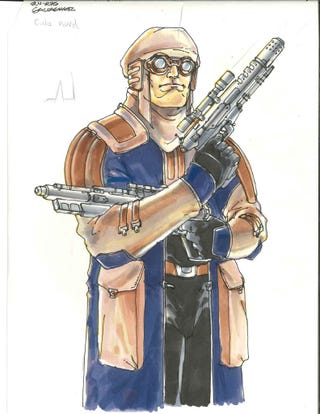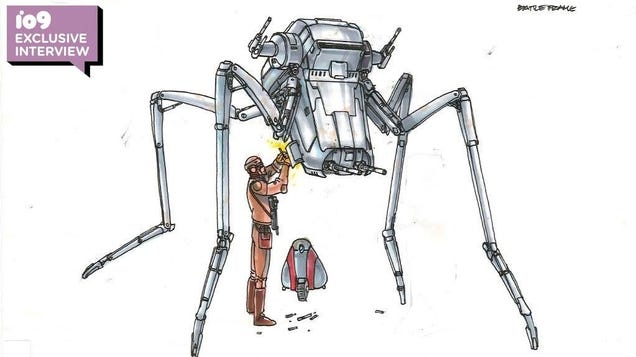The year 2003 felt like a banner one for Star Wars fans. We were coming off the release of 2002’s Attack of the Clones, and the wait for the “final” Star Wars film was filled with all manner of books, comics, video games, plus an animated micro-series from Genndy Tartakovsky. Among this deluge, one title managed to stand above the rest.
I’m talking about Knights of the Old Republic, which turns 20 this year. BioWare’s RPG not only shook up the gaming industry, but served as an epoch within Star Wars itself. Between opening up a new era of storytelling and introducing a cast of memorable characters, KotOR became an RPG behemoth whose influence is still felt in Star Wars today.
To celebrate Knights of the Old Republic’s two-decade milestone, I spoke with project director Casey Hudson about bringing the game to life, some little-known details about the development, and the impact it’s had overall. The concept art in this article comes courtesy of artist John Gallagher; we’ll have more to share in an upcoming feature focusing on his work.
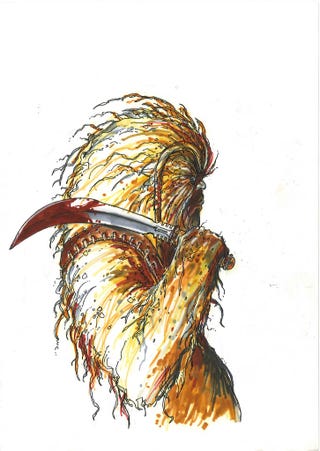
An Even Longer Time Ago…
“I can’t believe it’s been 20 years already. That doesn’t make me old though!” Hudson pointed out at the beginning of our discussion. In the time since its launch, the game has continued to influence fans via merchandise, and bits of lore frequently find their way into current projects.
As a young developer, however, Hudson and his team of roughly 75 people never anticipated the impact. “We would have been blown away by the player reaction that KotOR has received over the years … We were pretty ambitious about making something really special,” Hudson explained. “We had no expectations about what would happen next. At that time, BioWare had made some good games already. We just wanted to meet the expectations of quality and make something we would be proud of.”
In late 1999 and early 2000, Lucasfilm was eager to capitalize on the new wave of Star Wars love. Looking to expand into RPGs, LucasArts’ then-president, Simon Jeffery, approached BioWare after it had made a name for itself in the RPG world with the critically acclaimed release of Baldur’s Gate. LucasArts presented the company with two options: “One was to set the game in the timeframe of the movies—I think specifically the Original Trilogy. The other was a much earlier period. [They] pointed us to the comic series Tales of the Jedi, which explored the Old Republic, a time 4,000 years before the movies.”
Telling a story set during the classic films was a tempting prospect, but the decision to delve into the past was an easy one. “We wanted to tell the most important story of our era—meet legendary new characters, kill them off, destroy planets, and so on. We saw in the Old Republic an opportunity to have … creative freedom, while also having access to the essential parts of the Star Wars experience: Jedi, Sith, lightsabers, starships, etc.”

News spread fast throughout the company, and the excitement level was understandably high. “I remember shortly after hearing the news,” Hudson said. “I was … testing a level I was working on for MDK2. Greg [Zeschuk, BioWare co-founder] wandered by and we chatted about our excitement [for] doing a Star Wars game.”
Hudson’s role in developing KotOR came as something of a surprise. Having only been with BioWare for a couple years, he never imagined he’d be picked to lead such an ambitious title. “[I told Greg] the only disappointing thing about the project was it came to us so early in my career, because I would have loved to have a leadership role on such an incredible project … Greg and Ray [Muzyka] must have remembered that moment, because when it came time to select the project lead, I had the incredible fortune of being chosen.”
Being a project director was a dream come true for Hudson, despite the heavy workload it entailed. As he explains, taking on the task involved being “responsible for the overall creative direction, planning the schedule, and working with our publisher LucasArts. During a typical day I would review art and design work with the leads, play the game and make feedback notes, make plans for upcoming milestones, and do calls or business trips to meet with LucasArts. I helped out wherever I could, with bits of concept art, 3D modeling, and some technical things (like figuring out how to add lightmap shadows to our engine).”
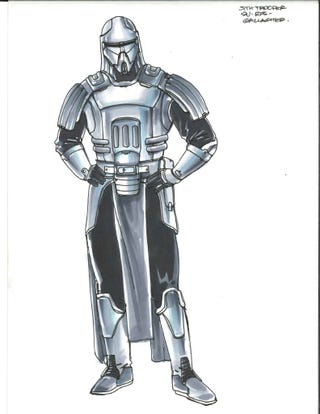
As a lifelong Star Wars fan, Hudson was more than willing to take on the challenge. “[The great] part of working on a Star Wars game,” Hudson pointed out, “was we occasionally traveled for meetings with LucasArts. Sometimes that would involve a trip to Skywalker Ranch. That place is pure magic for a Star Wars fan and we were absolutely in heaven each time we went there. It’s hard to describe the feeling of growing up obsessed with Star Wars, and then going to the place where we could walk among the people who created it.”
These Are Your First Steps
Looking back on Knights of the Old Republic’s development after 20 years and an illustrious career, Hudson still thinks of the experience fondly. “The best part was working so closely as a team at BioWare; inside such a magical IP. Everything people were working on felt incredibly exciting. [From simple things like] lightsaber blur … and level art … It was a thrill just walking around and talking with people about what they were doing!”
Every game has its fair share of ups and downs during development. KotOR was no different, but Hudson emphasized how their shared vision for the game made for a smoother process:
“We all knew what we wanted from the start. There wasn’t much hesitation or false starts—it’s amazing in retrospect how quickly we got to work on such a cohesive vision. Drew Karpyshyn was an extremely fast writer and the story developed quickly. James Ohlen knew what he wanted from the RPG systems. Level designs and maps came together really fast on the design side. Derek Watts and John Gallagher have an eye for Star Wars, which allowed us to start building art very early. Our first prototypes were spot-on in terms of visualizing the game we all wanted to make.”
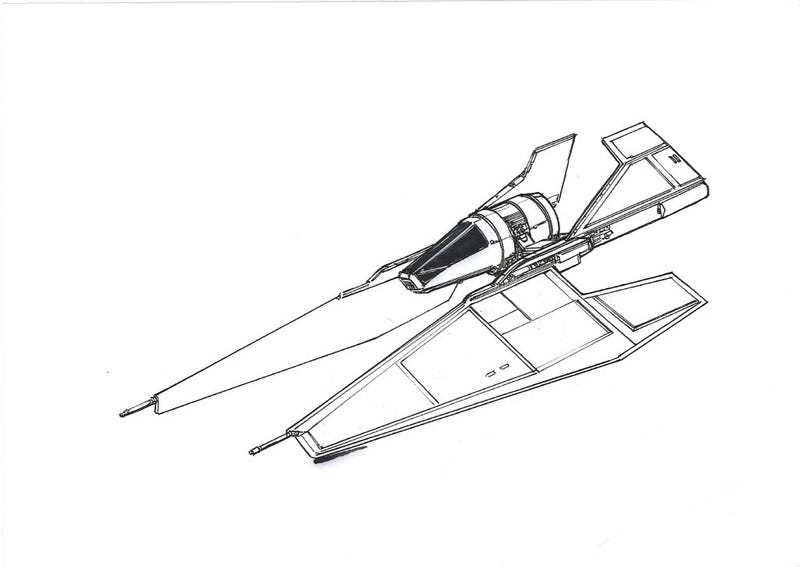
Just one year before the game’s launch they ran into an unexpected crisis dealing with KotOR’s combat system. It’s a system intimately familiar to players now, and felt almost revolutionary at the time for transforming the turn-based formula into something cinematic. Getting the idea across to players initially, however, was a surprising struggle.
“We took an early demo of the game to E3 in 2002,” Hudson explained. “People were mashing buttons like it was an action game, which would randomly start and cancel the combat system! With only a year left in development, we had a combat system players didn’t understand.”
“We needed a big change … We needed people to understand combat was a mode, and you were either in that mode or not. As part of that, we needed a way to visualize what was happening in the system itself. It was about queuing up actions for each character and letting those actions play out.

“[We] kicked off a competition to propose solutions. This led to an interface [with] a big ‘COMBAT MODE ENGAGED’ label, plus a visible queue showing the actions you’ve loaded up for each character. Fortunately, that approach worked and led to a really interesting, tactical combat scheme that made the most of our RPG systems.”
The final result speaks for itself, but even decades later, Hudson can’t imagine changing anything about it. “We hit the finish line on that production with something we really enjoyed playing ourselves. It’s almost exactly the game that we outlined in our early General Design Document … I don’t think we’ve given much thought to things we would have changed.”
A Galactic Legacy
KotOR was an instant success, becoming the fastest-selling Xbox title (at the time) within days, and went on to garner roughly 126 industry awards while continuing to find itself among “best of” lists all these years later. The characters and story had an immediate impact on fans. Thanks to novels, comics, and a sequel, the Old Republic era became a ripe place for storytellers. Characters like Revan and Bastila reached a level of familiarity previously only enjoyed by on screen characters. Even George Lucas once planned to bring Revan into The Clone Wars series in the “Ghosts of Mortis” episode (a scene that was eventually cut).
Beyond the story elements, Hudson feels the game served an important step in the gaming industry as a whole, “[We made] a game that felt like a cinematic experience. We conceived of a conversation system that used procedural cameras based on cinematography principles, gave our characters gestures and lip-synch animations while they spoke (new for us at the time), and planned continuous sequences…
“[What] stands out about it—even today—is the sense of agency. You really feel like you have a galaxy to explore however you want. You decide who you take with you on adventures, make important decisions, decide what planet to visit, and what to do there. At any time you can turn to one of your [companions] and continue a conversation with them.”
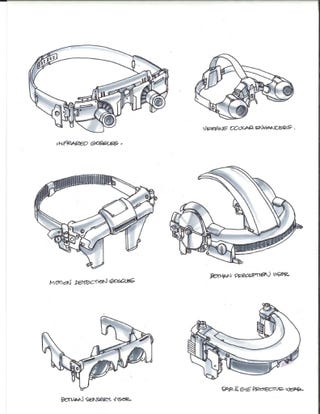
KotOR’s influence on the franchise is still keenly felt. From off-hand mentions in Star Wars Rebels, a plethora of Easter eggs across the books (most recently in Star Wars Jedi: Battle Scars from Sam Maggs), comics, and live-action shows—bit by bit, the lore Hudson and his team created is still helping to shape the galaxy far, far away.
“I would love to see more of the work we did in KotOR show up in the Star Wars canon,” Hudson laughed. “When you work for several years on something, it’s nice to see it live on and take new forms.
“I was at a comic store recently and they had the new Black Series Darth Revan figures. Two young fellows were checking them out and one said, ‘Whoa, they have Darth Revan!’ His friend responded, ‘Yeah, he’s popular now,’ and the first guy said, ‘He was always popular.’”
The awe extends to the ongoing The Old Republic MMO, which manages to keep the heart of KotOR alive, even among all the changes Star Wars has seen in recent years. “I was fortunate to work with that team, and it was awesome to see how they continue to bring their passion and dedication to the Old Republic era of Star Wars. It’s great to see players continue to show up for it.”
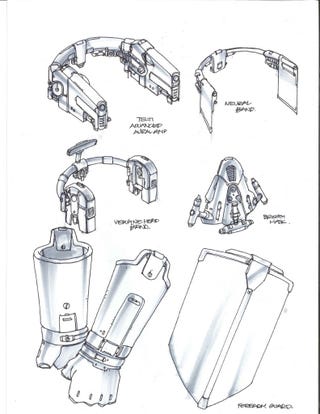
Between modern ports, an announced remake (which is… well, it’s doing something), and new merchandise being produced, Knights of the Old Republic feels just as important within the fandom as it was 20 years ago. There’s no telling what the future may hold, but one thing seems clear: we’ll be talking about KotOR and its impact for many more years to come.
Always in Motion
Hudson pointed out some interesting changes made early on that would have changed the KotOR, and characters, we know.
- The original title was “Age of the Jedi,” but LucasArts nixed that idea and suggested Knights of the Old Republic instead.
- Your Twi’lek companion, Mission Vao, was originally a teenage boy rather than a teenage girl.
- Speaking of Mission, Hudson originally disliked the name for the character and wanted it changed. After enough time passed, however, it kind of stuck.
- Art Director Derek Watts wanted to call the astromech unit T3-M3, but couldn’t convince the writers to change it from T3-M4.
- Originally, the culture of the Tusken Raiders was even more developed beyond what we saw in the game. There was big pushback on this as, “Lucasfilm didn’t want them to be developed as people much more than you see them in the initial trilogy.”
